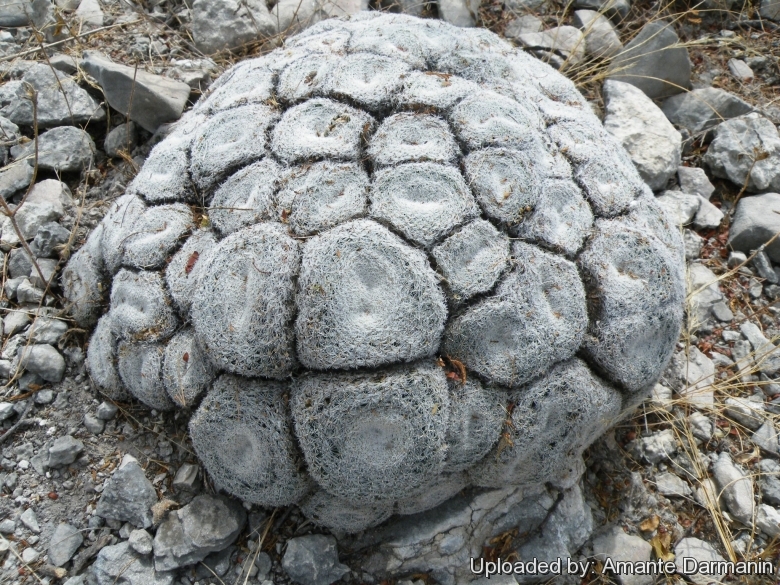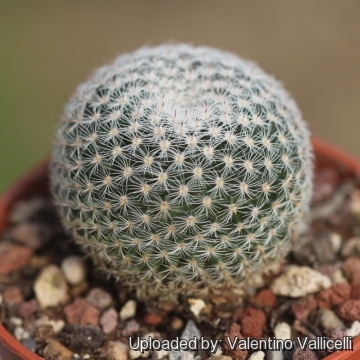Accepted Scientific Name: Mammillaria formosa subs. microthele (Muehlenpf.) D.R.Hunt
Mammillaria Postscripts 6: 9 (1997)

Mammillaria formosa var. microthele (Mammillaria formosa subs. microthele) Photo by: Amante Darmanin
Origin and Habitat: Mexico (Coahuila, San Luis Potosi, Tamaulipas).
Altitude: 1000-2200 metres above sea level.
Habitat: It is usually found in limestone slopes, hills and plains in xerophytic shrubland. It is a very common to abundant species that grows along with a rich succulent flora such as: Turbinicarpus jauernigiiSN|12713]]SN|12713]], Leuchtenbergia principisSN|12924]]SN|12924]], Thelocactus tulensisSN|1065]]SN|1065]], Echinocereus diguetii, Escobaria zilzianaSN|10435]]SN|10435]], Mammillaria surculosaSN|25329]]SN|25329]], Neolloydia conoideaSN|10089]]SN|10089]], Echinocereus pentalophus, Opuntia microdasysSN|15506]]SN|15506]], Ferocactus latispinusSN|4259]]SN|4259]], Coryphantha erectaSN|3941]]SN|3941]], Glandulicactus crassihamtaus often among shrubs of Agave lechuguillaSN|23013]]SN|23013]] and Hechtia glomerata.
More...Synonyms:
See all synonyms of Mammillaria formosa
Common Names include:
SPANISH (Español): Cabeza blanca
Description: Mammillaria formosaSN|15836]]SN|15832]] subs. microthele is a low-growing flattened plants, clumping with tight, short white spines which forms low, many-headed, mounds in time. Some authors consider Mammillaria formosaSN|15832]]SN|15832]] subs. microthele to be sufficiently distinct to deserve its own formal status: Mammillaria microtheleSN|15832]]SN|15836]].
Stems: Almost discoidal to globose, apically depressed, dividing dichotomously, each stem are up to 6 cm in diameter.
Tubercles: About 6 mm long, naked or woolly in their axils.
Radial spines: 22-24 tiny, white-setiform, spreading, 2 to 4 mm long that almost obscure the stem.
Central spines: 2, much stouter than the radials, 2 mm long or less.
Flowers: Small (3-5 mm) long in a ring around the sides of the stem, nearly pure white to flesh-coloured without, white within.
Blooming season: Flowers are produced in spring over a several weeks period.
Fruits: Clavate, 10 (or more) mm long.
Seeds: Rather large, black.
Remarks: The so called “superfina” is a particular nice selected form with even more small tubercles and spines.
More...Subspecies, varieties, forms and cultivars of plants belonging to the Mammillaria formosa group
 Mammillaria formosa Galeotti ex Scheidw.: has pale pink flowers and 20-22 white radial spines. Distribution: Coahuila, Aguascalientes, Guanajuato, Zacatecas, Tamaulipas, Nuevo Leon, and San Luis Potosi.
Mammillaria formosa Galeotti ex Scheidw.: has pale pink flowers and 20-22 white radial spines. Distribution: Coahuila, Aguascalientes, Guanajuato, Zacatecas, Tamaulipas, Nuevo Leon, and San Luis Potosi. Mammillaria formosa subs. chionocephala (J.A.Purpus) D.R.Hunt: is typically wrapped on the upper part with a dense snow-white wool, so that only the tips of the tubercles visible. Distribution: Highlands of central Mexico (Coahuila, Nuevo Leon, and Durango).
Mammillaria formosa subs. chionocephala (J.A.Purpus) D.R.Hunt: is typically wrapped on the upper part with a dense snow-white wool, so that only the tips of the tubercles visible. Distribution: Highlands of central Mexico (Coahuila, Nuevo Leon, and Durango). Mammillaria formosa subs. microthele (Muehlenpf.) D.R.Hunt: has nearly pure white flowers and 22-24 flattened and bristle-like radials. Description: Coahuila, Guanajuato, Tamaulipas, and San Luis Potosi.
Mammillaria formosa subs. microthele (Muehlenpf.) D.R.Hunt: has nearly pure white flowers and 22-24 flattened and bristle-like radials. Description: Coahuila, Guanajuato, Tamaulipas, and San Luis Potosi. Mammillaria formosa subs. microthele var. superfina hort.: it is a particular nice selected form with very small tubercles and spines.
Mammillaria formosa subs. microthele var. superfina hort.: it is a particular nice selected form with very small tubercles and spines. Mammillaria formosa subs. pseudocrucigera (R.T.Craig) D.R.Hunt: has distinctly pink flowers with white margins and only 18 radials, often lacking on mature areoles. Distribution: Queretaro and Guanajuato.
Mammillaria formosa subs. pseudocrucigera (R.T.Craig) D.R.Hunt: has distinctly pink flowers with white margins and only 18 radials, often lacking on mature areoles. Distribution: Queretaro and Guanajuato.
Bibliography: Major references and further lectures
1) David Hunt, Nigel Taylor “The New Cactus Lexicon” DH Books, 2006
2) John Pilbeam (1999) “Mammillaria The Cactus File Handbook” Nuffield Press.
3) Nathaniel Lord Britton, Joseph Nelson Rose “Cactaceae: Descriptions and Illustrations of Plants of the Cactus Family” vol. 4 The Carnegie Institution of Washington, Washington 1923
4) Stuart Max Walters “The European Garden Flora: Dicotyledons (Part I)” Cambridge University Press, 1989
5) Edward F. Anderson “The Cactus Family” Timber Press, 2001
6) Fitz Maurice, B, Fitz Maurice, W.A., Hernández, H.M., Sotomayor, M. & Smith, M. 2013. Mammillaria formosa. In: IUCN 2013. “IUCN Red List of Threatened Species.” Version 2013.2. <www.iucnredlist.org>. Downloaded on 01 January 2014.
More... Mammillaria formosa var. microthele (Mammillaria formosa subs. microthele) Photo by: Valentino Vallicelli
Mammillaria formosa var. microthele (Mammillaria formosa subs. microthele) Photo by: Valentino VallicelliSend a photo of this plant.The gallery now contains thousands of pictures, however it is possible to do even more. We are, of course, seeking photos of species not yet shown in the gallery but not only that, we are also looking for better pictures than those already present.
Read More... Cultivation and Propagation: Mammillaria formosaSN|15832]]SN|15832]] subs. microthele is a slow growing species.
Soil: Use pot with good drainage and a very porous mineral-based potting mix.
Watering: Keep dry in winter. Pot plants are quite wet-sensitively. Care must be taken with watering (Rot prone) and needs good drainage. Water sparingly during the growing season, keep very dry in winter.
Fertilization: Feed with a high potassium fertilizer in summer.
Hardiness: Usually it is recommended to overwinter this plant in a bright and warm greenhouse with at least 8-10° C , but it proved to be quite frost resistant (if kept dry it hardy as low as -10° C)
Exposure: Outside full sun or afternoon shade, inside needs bright light, and some direct sun.
Propagation: Direct sow after last frost, cuttings (if available).
More...











